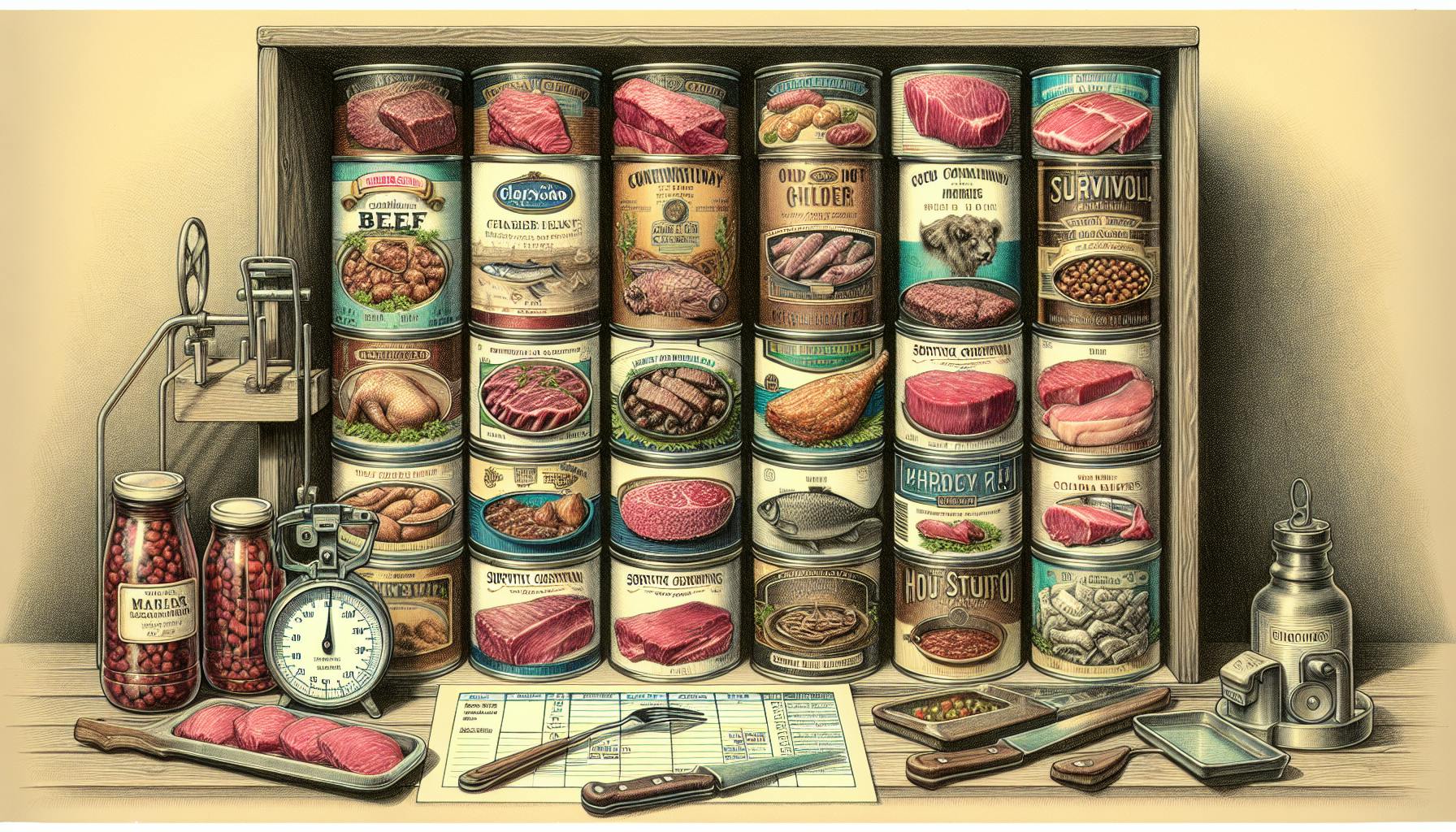When building a bug out bag, having a comprehensive first aid kit is crucial for handling medical emergencies.
This article explores the essential items your bug out bag first aid kit needs so you can effectively treat injuries and illness when SHTF.
You'll discover the critical over-the-counter medications, medical instruments, and personalized supplies your kit should contain based on your health profile and potential evacuation environments.
Introduction to Bug Out Bag First Aid Kit Essentials
Understanding the Bug Out Bag
A bug out bag is an emergency kit filled with supplies to help you survive for at least 72 hours if you need to evacuate quickly. It contains gear like food, water, shelter, clothing, navigation tools, and first aid items. Having a well-stocked medical kit is essential because you likely won't have access to pharmacies or hospitals.
The purpose of a specialized first aid kit for bug out bags is to treat injuries and illnesses when professional medical care is inaccessible. It needs to be lightweight and portable yet contain critical supplies.
The Role of First Aid in Survival Situations
First aid skills and supplies can literally make the difference between life and death in a disaster scenario. Knowing how to treat medical issues allows you to help yourself and others. Key reasons a first aid kit is vital for bug out bags:
- Injuries like cuts, burns, sprains are common during disasters
- Pre-existing medical conditions may require medications
- Evacuations may separate you from healthcare providers
- Stress negatively impacts health; first aid stabilizes issues
- Allows you to keep moving to safety quickly if needed
Having the right first aid gear can buy you time until you can get proper medical care. The supplies treat issues, manage pain, prevent infections, and more. They safeguard health when professional services are delayed or inaccessible.
What should be in a bug out first aid kit?
A well-stocked first aid kit is an essential component of any bug out bag. At a minimum, your bug out bag first aid kit should contain:
- Bandages: Assorted adhesive bandages, gauze pads, rolled gauze, and medical tape to treat cuts, scrapes, and wounds.
- Antibiotic ointment: To prevent infection in minor cuts and scrapes. Look for antibiotic ointments containing bacitracin, neomycin, or polymyxin B.
- Antiseptic wipes: To clean wounds and skin prior to bandaging. Alcohol wipes and iodine pads are good options.
- Pain relief medication: Ibuprofen, acetaminophen, aspirin to relieve pain and reduce fever.
- Anti-diarrheal medication: Help treat gastrointestinal issues.
- Antihistamines: Treat allergic reactions and symptoms.
- Tweezers: Remove splinters, glass shards, stingers, ticks.
- Trauma supplies: Tourniquets, compression bandages, trauma pads, medical gloves.
Customize your first aid kit based on your medical needs, skills, environment, and bug out plan. Periodically inspect and replace expired items. Consider taking a wilderness first aid course to enhance your medical preparedness. With the right supplies and training, you can effectively treat injuries in a disaster scenario.
What is needed in a bug out bag?
A well-stocked bug out bag is crucial for emergency preparedness. Here are some of the most essential items to include in your bug out bag first aid kit:
- First aid supplies - These form the core of your medical preparedness. Have a variety of bandages, gauze, wraps, antiseptic wipes, antibiotics, pain relievers, etc. A bug out bag first aid kit should allow you to treat cuts, burns, sprains and other common injuries.
- Personal medications - Pack at least a week's supply of any prescription medications you take. Include common over-the-counter meds like antihistamines, antacids, laxatives etc.
- Tools and instruments - Have a thermometer, tweezers, scissors, safety pins, etc. Consider packing a suture kit and sterile gloves if you have the knowledge to use them.
- Special needs items - If anyone in your family requires healthcare equipment like inhalers or EpiPens, pack extras.
The exact contents will vary based on your skill level, environment and specific risks. But these basics will help you handle most medical situations that may arise when bugging out. Be sure to check and resupply your first aid kit regularly.
What should be in an emergency go bag?
When preparing an emergency go bag, having the essential supplies readily available can make all the difference in an unexpected crisis situation. Here are some of the most important items to include:
Food and Water
Pack high-protein foods that won't spoil such as protein bars, nuts, beef jerky, and canned goods. Having 3 days worth of water stored in durable bottles is also crucial. Make sure to pack a can opener and eating utensils.
Communication and Light
Stay connected and visible with a phone charger, battery bank, hand-crank radio, flashlight, and extra batteries. Choose LED flashlights and battery banks with solar charging capabilities.
First Aid Supplies
A compact first aid kit tailored for emergencies on-the-go is vital. Essentials include bandages, gauze, antibiotic ointment, medical tape, trauma shears, pain medication, safety pins, and latex gloves. Personal medications are also important to bring.
Sanitation and Hygiene
Include personal care items like toilet paper, moist towelettes, toothbrush, toothpaste, dental floss, soap, feminine products, extra glasses or contacts, and a multi-purpose tool. Items that provide comfort can help in stressful scenarios.
Preparing an emergency go-bag with food, water, communication tools, first aid, and sanitation supplies can help you handle unexpected crises. Tailor your bag to your personal needs and update it every 6 months.
What must be inside the first aid bag kit?
A well-stocked first aid kit is essential for any bug out bag. Here are some of the key items you'll want to include:
Bandages and Dressings
- Gauze rolls in multiple sizes - these can be used to wrap sprains or secure dressings
- Sterile gauze pads in small and large sizes - helps stop bleeding and protect wounds
- Adhesive bandages in assorted sizes - for minor cuts and scrapes
- Elastic bandage - to wrap sprained ankles or knees
- Sterile nonstick pads - won't stick to wounds
- Eye pad - protects injured eyes
Medications
- Ibuprofen or acetaminophen - reduces pain and fever
- Antihistamine - helps alleviate allergic reactions
- Antibiotic ointment - prevents infection in wounds
- Hydrocortisone cream - relieves skin irritations and rashes
Other Essentials
- Nitrile gloves - protect hands when treating others
- Trauma shears - cut away clothing to access wounds
- Tweezers - remove splinters or debris from wounds
- Thermometer - take body temperature
- Glow sticks - use as emergency light to see in the dark
Tailor your first aid kit to the specific medical needs of those in your household. Having these basic supplies on hand will help you effectively treat injuries when bugging out.
sbb-itb-b932644
Building the Best Bug Out Bag First Aid Kit
Assembling a comprehensive first aid kit is a crucial part of preparing your bug out bag. Having the proper medical supplies on hand could mean the difference between life and death in an emergency situation where professional medical care is unavailable. This section outlines the essential components you'll want to include in your bug out bag's medical kit.
Essential Components of a First Aid Kit
When building your bug out bag first aid kit, be sure to carry a wide assortment of wound care supplies:
- Bandages: Include an array of bandage sizes, from large trauma pads to small bandages for minor cuts. Carry gauze rolls, elastic wraps, butterfly closures, and adhesive bandages.
- Antiseptic ointments: Stock up on antibiotic ointment, antiseptic wipes, hydrogen peroxide, and rubbing alcohol to clean and disinfect wounds.
- Medical tape: Packing tape, cloth athletic tape, and adhesive bandages are useful for securing dressings over injuries.
- Burn relief spray and aloe vera gel: These can provide pain relief for minor burns.
- Splints: Carry a compact arm and leg splint to immobilize broken bones.
The best bug out bag first aid kit will have ample wound care supplies to handle lacerations, abrasions, burns, sprains, and fractures until you can get advanced medical treatment.
Over-the-Counter Medications to Include
Be sure your medical kit contains common over-the-counter medications to relieve symptoms for frequent ailments:
- Pain relievers like ibuprofen help alleviate headaches, fever, and pain.
- Antihistamines can treat allergic reactions and symptoms.
- Antidiarrheals provide relief for diarrhea and vomiting.
- Electrolyte supplements replace lost nutrients.
Having a supply of basic OTC meds prepares you to manage illness and injuries during an emergency scenario.
First Aid Tools and Instruments
Round out your bug out bag medical kit with these essential tools:
- Scissors and tweezers – for removing debris and extracting splinters
- Alcohol wipes – disinfect tools and surfaces
- Thermometer – take body temperature
- Gloves and face mask – avoid contact with bodily fluids
- QuickClot – stops bleeding for severe wounds
- SAM splint – stabilizes injured limbs
- Space emergency blanket – retains body heat
Having basic medical instruments equips you to assess vitals, stop bleeding, immobilize breaks, and stabilize your condition until you can get to safety.
Preparing a bug out bag first aid kit takes some time and planning. But having emergency medical supplies on hand could save your life when SHTF. Follow this checklist to ensure you have wound care essentials, OTC meds, and basic tools to manage medical situations. With the right preparations, you can handle health emergencies and get through critical situations during disasters.
Bug Out Bag Medical Kit List: Additional Supplies
Supportive Gear: Splints and Slings
Having the proper supportive gear to immobilize injuries and stabilize broken bones is crucial when packing a first aid kit for your bug out bag. Here are some recommended items to include:
- Splints - These help restrict movement of injured limbs. Consider packing SAM splints, inflatable splints, or makeshift splints made of sticks/cardboard.
- Slings and swathes - Slings made of bandages, cloth, or commercial products can provide support for arm injuries. Triangle bandages work well.
- Braces - Ankle or knee braces provide stabilization of joint injuries when on the move.
When using splints/slings remember to elevate the injury above heart level when possible. Properly immobilizing injuries helps reduce pain and further damage. Practice applying splints and slings beforehand to be prepared.
Personalized Specialty Medications
Any group member with existing medical conditions like diabetes, asthma, severe allergies, etc. should pack an ample supply of needed prescription medications and devices in their bug out bag. For example:
- Insulin - Those with diabetes should have enough insulin and syringes/pens to last several weeks minimum.
- Inhalers - Asthma sufferers need to account for environmental asthma triggers when packing extra inhalers.
- EpiPens - For those with life-threatening allergies, having multiple EpiPens and allergy medications on hand is vital.
- Any daily prescription meds - Pack quantities suitable for your evacuation plans. Don't forget things like heart medications, antibiotics, etc.
The key is tailoring your first aid supplies to the specific medical needs of your group. Do an assessment ahead of time and set reminders to routinely verify nothing has expired. Rotating stock helps too. Being prepared with vital medications can save lives if disaster strikes.
Tactical Bug Out Bag: Integrating First Aid
Integrating first aid elements into a tactical bug out bag allows you to maximize space and ensure quick access to medical supplies when needed most. Careful planning and strategic packing techniques are key.
Strategic Packing for Quick Access
When packing your bug out bag first aid kit:
- Place medical items in the top or outside pockets for fast access without unpacking.
- Consider color coding and labeling supplies for visual identification.
- Map out your packing configuration to memorize where items are located.
- Prioritize injury-specific modules - trauma, burns, airway, etc.
- Attach basic supplies like bandages and gauze to the exterior for immediate use.
Mapping out your first aid kit packing allows for muscle memory retrieval of items when under duress. Grouping related medical gear also assists in faster diagnosis and injury response times.
Durability and Protection of Medical Supplies
Protecting your first aid equipment from crushing, moisture, and other damage is critical to ensuring functionality when you need it most.
Consider using:
- Rigid containers like waterproof cases or hard-shell organizers to prevent crushing.
- Double bagging for lightweight moisture protection.
- Padded pouches to shield fragile items like thermometers.
- Silica gel packs to absorb excess moisture over long periods.
- Clear storage to easily identify contents without unpacking.
Taking steps to safeguard your medical provisions will give you confidence they will be operational even after extended tactical use of your bug out bag. Investing in durable storage solutions ultimately protects your health and safety as well.
Personalizing Your Bug Out Bag List with First Aid Considerations
Tailoring the medical components of your bug out bag to reflect personal needs and potential scenarios is key to being prepared for any emergency.
Assessing Individual and Group Health Needs
When packing your bug out bag first aid kit, carefully evaluate the specific health requirements of both yourself and anyone else in your group. Consider any medical conditions, medications, allergies, or previous injuries that may need specialized care. Having this understanding will allow you to customize your supplies to address potential health issues.
For example, if you or someone in your group has asthma, pack extra inhalers along with allergy medications. If you take daily prescription drugs, bring enough for the duration you'll be away from home. Knowing about health factors ahead of time ensures you can meet individual needs.
Environmental Factors Influencing First Aid Needs
The environment you may need to bug out to can also impact the type and quantity of medical gear to include. For instance, areas with extreme weather may lead to temperature-related conditions like heat stroke, hypothermia or frostbite. Packing supplies accordingly, such as thermal blankets, electrolyte powders, and protective clothing, can counteract environmental risks.
Additionally, pack items that reflect potential hazards in the location. Extra bandages and disinfectants are wise if heading into wooded areas with rugged terrain and possible lacerations or puncture wounds. Areas with bodies of water necessitate water purification methods to prevent waterborne illnesses. Analyze probable environments and tailor your first aid kit to handle associated medical issues.
Carefully considering individual health factors and likely environmental conditions allows you to build a comprehensive bug out bag first aid kit for your unique situation. This ensures you have the right medical gear to handle any emergencies or injuries while away from home.
Conclusion: Optimizing Your Bug Out Bag First Aid Kit
Customizing your first aid kit to meet your specific needs is key for efficiency and preparedness. Here are some tips:
Customizing Your Kit for Maximum Efficiency
- Consider your medical history and needs - pack medications, supplies for managing chronic conditions
- Factor in your environment and likely injuries - extra bandages if hiking, allergy meds if camping
- Include items like moleskin for blisters if planning lots of walking
- Have tools to handle cuts, burns, sprains based on your activities
Maintenance: Replacing and Organizing First Aid Contents
- Check expiration dates every 6 months and replace expired items
- Restock after using something from the first aid kit
- Consider labeling compartments or bags for different categories of items
- Use clear plastic bags to organize and quickly find items
- Take inventory annually and update contents as needs evolve
Keeping your first aid kit up to date and organized is crucial for quick access in emergencies. Customize based on your needs and replace expired items regularly.


